
Marcus Hanke
[PuristSPro Moderator]
11515

Omega 9300 Speedmaster Professional Moonwatch chronograph in-depth review
Omega cal. 9300 Speedmaster Professional Moonwatch chronograph experience test
by Marcus Hanke
by Marcus Hanke
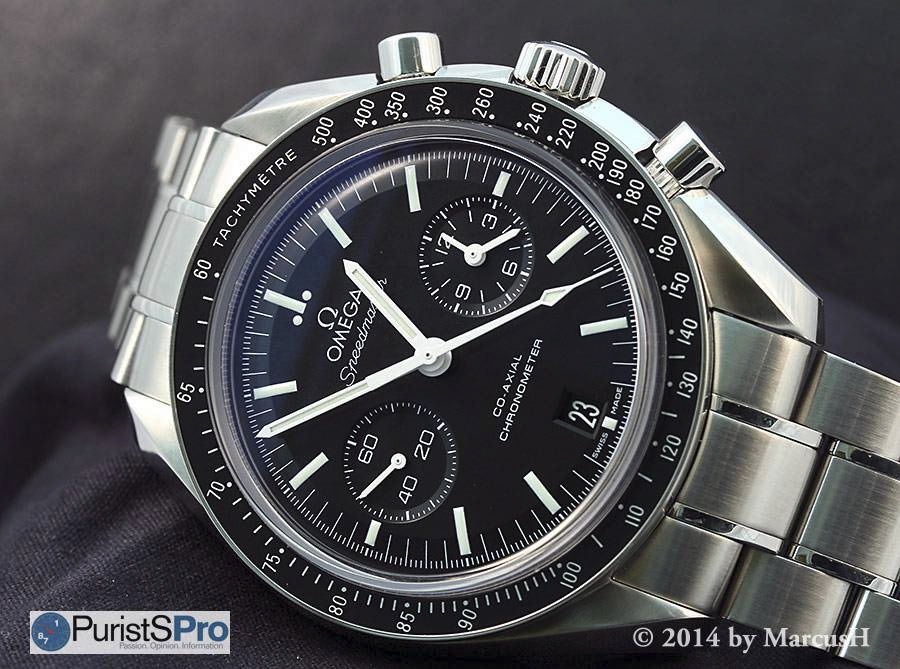
I can safely assume that the two most iconic wristwatch models in history are the Rolex Submariner and Omega’s famous „Moonwatch“, the Speedmaster Professional. But while the Rolex did not see too many apparent changes and modifications, the Speedmaster is - I am sure - the watch model with the most variants and versions in the history of horology. Quite a long path has been taken after the Speedmaster Professional accompanied man’s first step onto the moon in 1969. It is really worth to read Jack Forster’s excellent and most concise article on the Speedmaster, which you can find here:
www.watchprosite.com (part 1)
omega.watchprosite.com (part 2)
While the most authentic Moonwatches were always equipped with manual winding movements, Omega released selfwinding variants soon. These, however, always played a minor role in the popularity ranking, with only a few exceptions, like the Speedmaster with automatic Lémania 5100 movement.
Most of the time, the basic layout of the Speedy Pro remained the same, with three subcounters for elapsed minutes and hours, and a small permanent second (again with the exception of the 5100-equipped model, that had a central minute counter, but a 24 hours indication in the third subcounter).
This era now comes to an end, with the advent of the celebrated new cal. 9300 movement. Unlike the traditional tri-compax subdial layout, chronographs equipped with the new movement feature a so-called bi-compax design with only two subdials at 9 and 3.

The cal. 9300’s uniqueness lies in the combination of the counters for elapsed minutes and hours in but one subdial at 3. However, the changes induced by the integration of the new movement are much more substantial, due to the state-of-the-art technology used. This will be thoroughly discussed in a later chapter of the review, though.
I. First Impression:
This watch is not thick. It is fat. Believe me, I am a heavyweight myself, and I know all those tricks to appear slimmer: vertical stripes, baggy clothes, dark colours - at the end of the day, one is still fat. Omega made use of all trickery available in watchmaking: a highly domed sapphire crystal not only above the dial, but also on the caseback tries to make watch substance vanish, at least when looked at from the side; the multi-stepped Speedmaster case with the exposed tachymeter bezel and many facets with variations of brushed and polished surface finishes further adds to the impression. As a result, the 9300 Speedmaster’s optical presence is a lot less obtrusive than that of the 9300 Seamaster Planet Ocean, which confronts the spectator with a massive lump of stainless steel more resembling an accessory of Marvel’s Ironman, than a wristwatch. Yet still, the new Speedmaster is very likely to become a most intimate friend with all door frames and furniture edges in your home.
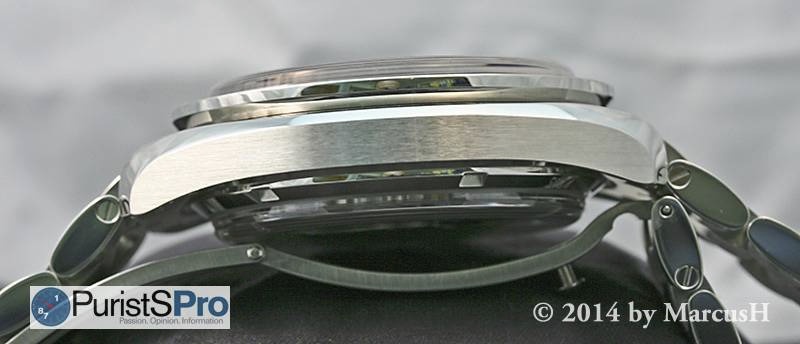
As soon as the wrist is turned a bit to get a clear view on the watch’s front, all snidely comments on its proportions are forgotten: this is a helluva attractive timepiece!
II. Case, Crystal and Crown:
As I had stated above already, the Omega chronographs equipped with the new cal. 9300 movement share rather high cases. However, with an overall height of 16mm, the 9300 Speedmaster Professional is only about a millimetre thicker than the average 7750-chronograph, but appears to be substantially higher. Since I did not want to rely on my own subjective perception, I asked several Omega dealers about their experiences with customer opinions: all of them confirmed that critical comments on the watch’s thickness (even more so on that of the massive Planet Ocean chronograph) are very common.
Then I measured two other Speedmaster chronographs that normally (myself included) are described as „nicely thin on the wrist“. To my astonishment, the classic hesalite handwinding Speedmaster Professional „Moonwatch“ is 14.5mm high, only 1.5mm less than the much larger new 9300 Speedmaster. The latter’s direct predecessor, the cal. 3313 movement-equipped Speedmaster Professional Co-axial, sitting on the wrist flat as a fluke, is even a little bit thinner, with a height of 14.22mm. Maybe it is due to its relatively large diameter of more than 44mm that it appears so thin, but the new 9300 Speedmaster with the same diameter should not appear so much fatter than the 2.78mm difference in height suggest.
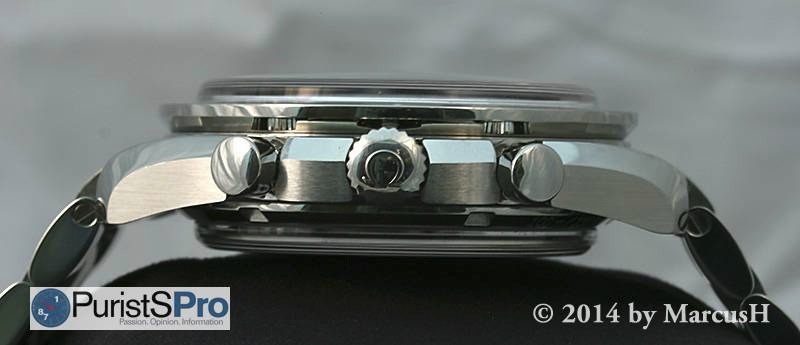
It seems that human perception of aesthetics and proportions are kicking in here, since only a slight deviation from what is generally considered „harmonious“ or „attractive“ appears to have a disproportionate negative effect on the reaction.
Leaving the proportions issue aside, the Speedmaster case is the perfection of a style established since roughly fifty years: The multi-stepped case has a mixture of brushed and polished surfaces, the „free-floating“ bezel ring with the tachymeter scale is practically begging for damages following rough contacts with the environment, but simply looks gorgeous, and is the iconic attribute of the „Moonwatch“. Its black insert appears to be ceramic, but this cannot be confirmed.
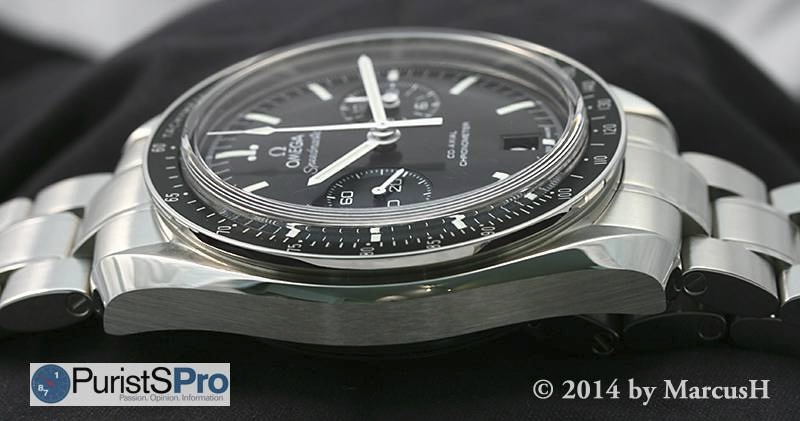
Quoting an exact value for the diameter is difficult on a Speedmaster case, since it is not completely symmetric, so it is differently sized on both sides of the crown, which itself is partially buried inside the case flanks. Generally, it can be stated as more than 44mm wide, and thus is on the upper end of the various Speedmaster variants. Water tightness rating is down to 100 meters, indicating an increased effort to tighten the unscrewed crown and pushers.

As already stated, the two sapphire crystals are domed very highly: the upper one to simulate the classic hesalite crystal of the hand-winding Speedmaster Moonwatch, and the crystal on the back permits an unusual view on the movement from the side - and does its best to camouflage the watch’s massive thickness. Both crystals have an efficient anti-reflective coating, the upper one on both sides, the rear one inside only.

Neither the substantial crown, nor the smooth and round pushers are screwed down, but are well protected by the uniquely designed case flanks. If the watch should be operated in very dusty or sandy conditions, the wearer should take a bit extra-care, because the layout invites dirt to sneak into the mechanics, causing scratches and rough operation.

III. Dial and hands:
Contrary to the first impression, the glossy black dial is not lacquered, but appears to be made from a black-coloured material. My first impulse would be to call the dial „a bit empty“, but I assume this is owed to the fact that I am used to the classical tri-compax dial layout. Quickly, the beauty of the clean, uncluttered dial becomes apparent. A huge advantage is the relatively large date window at 6. Together with the bold font used for the date numbers, this permits an excellent legibility of the date, what is certainly not a common feature even on recently developed movements.

The luminous hour markers are wider than on the previous Speedmasters, resulting in a very clear night legibility. Halfway through the hour markers, and touching the shorter minute markers, is a noticeable bevel in the dial. All printing is crisp and sharp, no dust is spoiling the excellent impression of a flawless dial.

The hands follow the classic Speedmaster design: slim and straight, equipped with sufficient luminous material, they offer excellent contrast with the black dial. Thankfully, Omega did not jump the current fashion train of employing the attractively bright white, but much less potential C1 SuperLuminova, but stayed with the greenish, highly effective C3 SL. This pays off at night, when the time is perfectly legible even at dim ambient light, and after many hours of darkness.

What appears to be a classic bi-compax chronograph layout at first sight, reveals itself as a fully functional 12 hours measuring chronograph at a closer glance: the subcounter at 3 contains two stacked hands, the longer one counting 60 minutes, the shorter 12 hours. Together they are a complete small watch dial. This is a feature that sets the new cal. 9300 movement apart from its competitors, which mostly show the elapsed time on several separate subdials.

A close inspection of the hands from the side reveals two things: Firstly, the reason why the cal. 9300-watches are so high, while the movement itself is even 0.3mm thinner than an ETA/Valjoux 7750, lies in the stack of hands, notably the combined chronograph minutes and hours hands. On normal chronographs, the lowest central hand, the hour hand, only has to pass over one layer of subdial hands. But here, there are two, even with ample space between each other, which facilitates the assembly and reduces the chance of collisions in case that one hand becomes slightly bent after a massive shock. As a consequence, the upper crystal has to be placed at least a millimetre higher above the dial than on a conventional chronograph.

The second issue visible from the side is the slightly flawed finish of the hands’ flanks. Apparently, it is very difficult to obtain painted hands without paint spray or other imperfections from the suppliers. Compared with other hands I have recently shown here, though, the Omega hands are acceptable.

IV. Movement:
The real raison d’être of this Speedmaster Professional is the new cal. 9300 movement. The direct predecessor, the cal. 3313-equipped Speedmaster Professional Co-axial, was built only for some three or four years. As it seems today, the production of the cal. 3313 has been discontinued altogether, since only recently, Omega introduced its own cal. 7750-offspring, the cal. 3330 with column wheel and co-axial escapement.
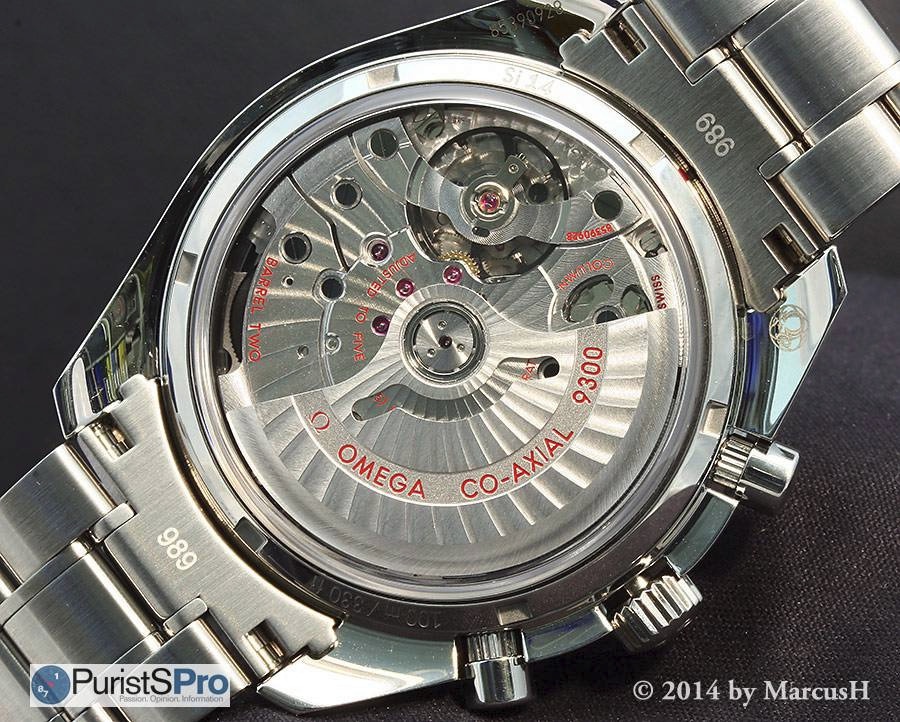
A lot has been written already on the new 9300 chronograph movement and its qualities, so I will concentrate on the most important features here: It is Omega’s first chronograph movement specifically designed for the co-axial escapement from scratch, while the above-mentioned cal. 3313 originally was launched with a Swiss lever escapement. This originality would have permitted the development team to chose a design with a better view on the unique escapement and how it works. This chance, unfortunately, has not been taken. As a consequence, the escapement remains practically invisible, with the exception of the black titanium balance and the silicium hairspring.

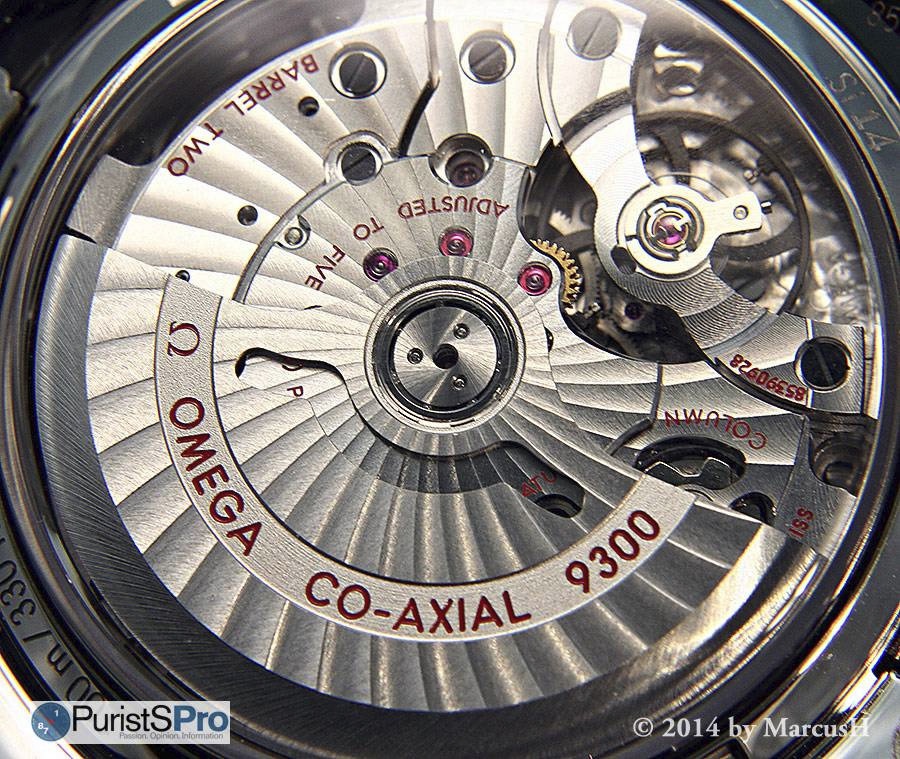
This buttoned-up design is a leitmotif of the whole movement, negating what, originally, made mechanical chronograph movements so attractive: the bulk of wheels, levers and springs all working together and moving whenever the chronograph function is activated - or stopped. Instead, the Omega cal. 9300 covers everything with thick bridge plates, with only small cutouts offering a glimpse on - something beneath. To add a distant impression of the movement’s key components, bright red engravings state „column wheel“, „barrel one“ and „barrel two“ - I wonder why „escapement“ and „rotor“ are missing.

Most people looking at the movement for the first time, will be literally flabbergasted because of the spectacular decoration with wave-like, radial stripes and bright red engravings. In my opinion, however, this is more cheap showiness than real beauty. When compared with graphical design, I’d consider it „shouting“, and it would nicely match a pimped American muscle car. Well, I like muscle cars as any other man, but considering Omega’s tradition in classic movement finish, the current movement generation clearly marks a departure from this tradition; not for the better. This impression is even enhanced by the movement’s „luxury“ version, with red gold-coated rotor and balance bridge, dubbed cal. 9301.
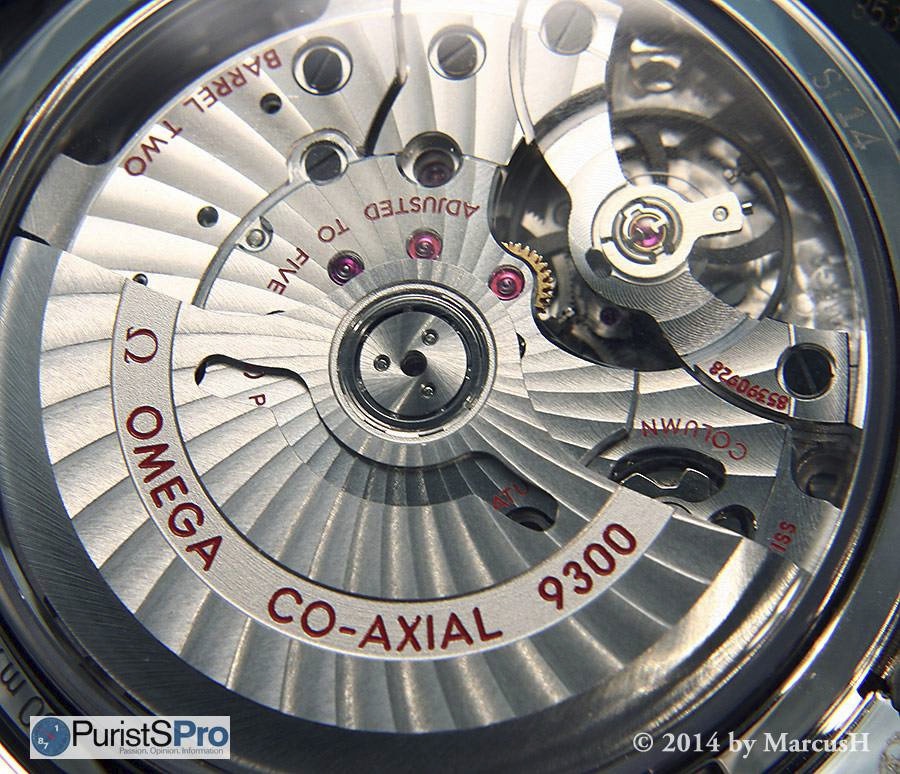
I am also surprised to see that the two large, serially installed mainspring barrels do not result in a higher power reserve than 60 hours; a value not much higher than its cal. 3313 predecessor had with but one barrel. I suspect the co-axial escapement consumes more energy than a Swiss lever escapement would (the cal. 3303 movement, differing from the 3313 only in its Swiss lever escapement, had three hours more power reserve than the latter), and the modern cal. 9300 was designed from the outset for a very even energy output to the escapement.
Aesthetic considerations left aside, the quality of the finish is very good, given that the movement parts are produced in large quantities and do not receive a specific manual finish. The heat-blued screws have crisp outlines, and are bare of any abuse. Only a few very slight scratches on some bridges give evidence of the assembly process.


V. Accuracy:
A watch movement’s primary purpose is to perform accurately and reliably, and this is where the tested Omega really excels. Never since I conduct accuracy tests with my watches (own and test specimen) I had a watch running so accurately, in all positions, as the 9300 Speedmaster. Its accuracy is simply marvellous. Just as a reminder: My test procedure is not based on an electronic timing device, but I follow the system of the Swiss COSC, the chronometric test institute. That means, I fully wind the watch every 24 hours, and check its accuracy in every position. This is done for two consecutive days in every position, to note the variation within the same position. The main difference, compared with the COSC, is that I do not test for heat, since I have no appliance able to store a watch at constant 37 degrees Celsius. I do subject the watch to cold (+5 degrees) in the dial up position for 24 hours, though. Additionally, I check all six positions, while the COSC does only five, and for watches with a power reserve of more than 48 hours, I also check the accuracy on the second day after full winding, to see whether the performance differs noticeably from the value on the first day, with the mainspring at high tension. Finally, of course, the performance is measured daily when the watch is worn 24/7 during normal everyday activities for at least a week. Altogether, my accuracy test consumes about a month.
I admit that this testing procedure has its own weaknesses, since it does not permit an evaluation of the momentary performance in a specific moment, but only benchmarks the average of given 24 hours intervals. However, the widely acceptance and tradition of the COSC test method offers a broad base for comparison and an established standard.
To quote but the key accuracy values of the 9300 Speedmaster Professional (chronometer limits in brackets):
Average daily rate: +1.23 (?4/+6)
Mean variation in rates: 0.64 (2)
Greatest variation in rates in one position: 2 (5)
Difference between rates in H & V positions: 1.25 (?6/+8)
Largest difference between the average rate and the largest deviation in any position: 2.23 (10)
Additionally, there is no noticeable difference between the values with chronograph running (for 24 hours) and stopped, and the performance of the second days running (the time from hour 24 to hour 48 without winding) differs only one second from the values of the previous days, started with fully wound mainspring.
This absolutely excellent performance is reproduced on the wrist, when the watch is worn 24/7. The minimum daily gain is zero, the maximum gain is 1.5 seconds, so after a week, I got an average daily gain of a mere 0.57 seconds.
I consider this absolute state of the art, regarding the accuracy of mechanical chronograph movements. We have to keep in mind that this is not a hand-tweaked competition chronometer, but a mass-produced watch, taken from the standard series. All other watches on the market will have to be measured against this cal. 9300 movement and the watches equipped with it.

That Omega delivers all their 9300 Speedmasters as officially certified COSC chronometers is a nice touch. I am really curious to learn the failure rate of the movements entered for the test. Somehow, I doubt that there is any at all.

VI. Bracelet and clasp:
The Speedmaster bracelet has seen only minor changes through the last decades: the material has become a bit thicker, and the removal of links, that in earlier times had to be accomplished by hammering out pins, is now easier, since the links are attached by screws. The attractive variation of slim and polished parts and wider links with brushed finish has become a well-known design element of the Speedmaster series, and I am glad to see Omega remaining loyal to it.


One aspect deserving improvement, however, is the folding clasp. While it is solid, well-finished and easy to operate, due to its two release pushers, it has still no integrated fine-adjustment for the bracelet length, which should be standard with any high-class timepiece today. Aside from that, the large, brushed cover plate of the clasp is a veritable scratch magnet.


VII. Ergonomics:
When actually using the 9300 Speedmaster Professional every day, the initial fear, regarding the consequences of the watch’s height, is found to be justified: whenever there is an edge or surface near the left wrist, the wearer can be sure to hear its approach by a clear „dang!“. No door frame, no table top is spared. Thank god the domed sapphire crystal is highly scratch resistant. But be careful: sapphire is much more brittle than hesalite, and a direct hit by a hard edge at the top of the crystal might cause it to shatter. Hiding the Speedy under the shirt cuff is an equally delicate task - one better does not even try it at all.
Leaving aside the „height“ chapter, the large watch is surprisingly comfortable to wear. While its overall weight is massive, at 180 grams, a large share of this is in the bracelet, which balances the watch very well. I suspect this positive distribution of mass will change to the worse with a leather strap attached, but I have not tried this.
Besides its almost magical accuracy, the cal. 9300’s major innovation is the combined chronograph counter at 3. Unlike the classic way of interpreting the elapsed time, but reading every subdial separately and adding the values in the head, the combined subcounter is much more intuitive, since it resembles a small, separate watch dial. This works perfectly, indeed. Only a very quick glance is necessary to see that, for example, four hours and about seven minutes have passed since the chronograph was activated. But, hold on: about? Why not: exactly?

Contrary to my expectation, the new subdial layout made the accurate reading of the elapsed time much more difficult than the conventional Speedmaster Professionals. At a quick glance, it is practically impossible to state whether seven or eight minutes have passed. The reason for this is the relatively small diameter of the chronograph subcounter, which now has to accommodate 60 subdivisions, instead of only 30 on the conventional 30 minutes-counters. As a consequence, the available space for the subdivisions along the subdial’s contour has been divided in half. Add to this the fact that the cal. 9300 does not move the stop minute hand in instantaneous jumps every full minute, but continuously, the difficulties to achieve a clear, quick reading of the elapsed time are comprehensible.
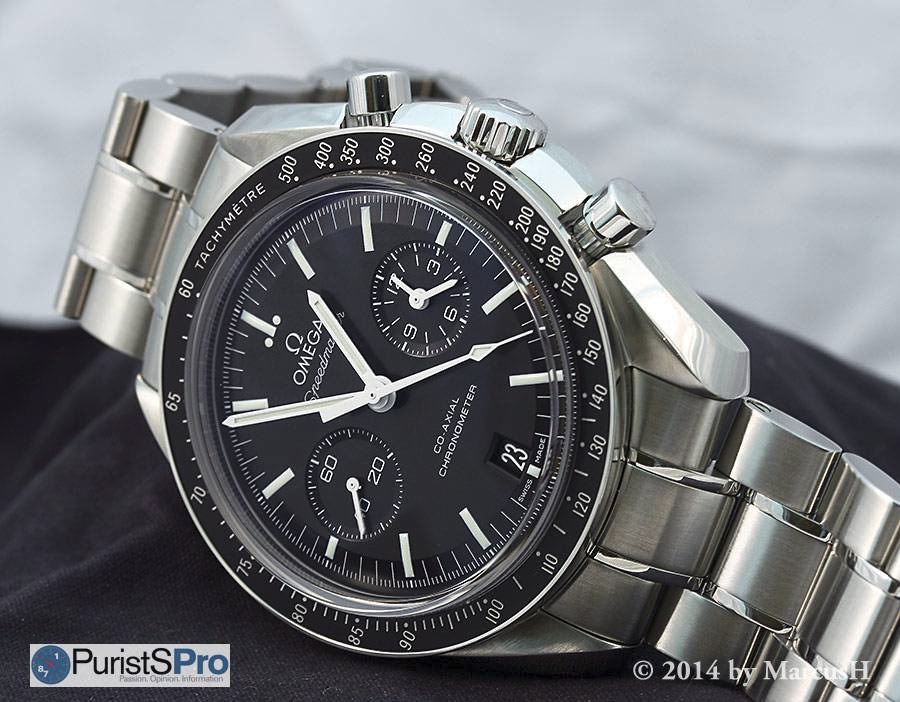
There would have been more space available to make larger subdials, and it seems that the new 1957 series of the Speedmaster benefits from a larger radius.
Other than that, the legibility of the time in any lighting condition is excellent. It is no wonder that the Speedmaster Professional established the reference standard for a highly legible chronograph already decades ago.
VIII. Conclusion:
To be honest, the 9300 Speedmaster Professional causes conflicting emotions in me: On the one hand, I am convinced it is the technically most advanced Speedmaster ever made. Its new cal. 9300 movement takes its performance to the extremes, I would compare it to the engine of a formula one racing car. However, my experience review also shows this performance has its price: the drawbacks are the ungainly proportions of the watch, and the difficulty to make a quick and accurate reading of the elapsed minutes on the combined subcounter. While the latter is quickly comprehensible for anybody using the chronograph, the former is based on my personal and individual feeling. A quick research among my fellow watch enthusiasts shows that I am not alone with my opinion. And I think that an anachronistic device like a mechanical chronograph, that is a pure luxury accessory, should not exclusively focus on technical excellence alone, but also satisfy the aesthetic needs of its owners, it should simply be --- beautiful. Neither to the cal. 9300 movement in detail nor to the watch as a whole I can attribute this without reservations. Yet, whoever is a fan of technical peak performance, of the very best currently available in this field, will become a happy wearer of the 9300 Speedmaster Professional.

Copyright February 2014 - Marcus Hanke & PuristSPro.com - all rights reserved
PuristSPro Homepage | ThePuristS Homepage
This message has been edited by Dr No on 2014-03-14 07:55:15
More posts:

Omega 9300 Speedmaster Professional Moonwatch chronograph in-depth review
Omega cal. 9300 Speedmaster Professional Moonwatch chronograph experience test by Marcus Hanke I can safely assume that the two most iconic wristwatch models in history are the Rolex Submariner and Omega’s famous „Moonwatch“, the Speedmaster Professional....

What a review marcus!
Thanks a lot for taking the time to share this. I have an old Mark IV, Lemania base engined, but I'm also really interested in what they did with the 9300. Very interesting technically speaking, though a bit thick. Cheers, Mark

An image can only . . .
. . . hint; your review reveals . Glad to learn my experience with the Aqua Terra annual calendar was not atypical; that iteration of Omega's movement technology was similarly outstanding. Remarkable insights and acumen, as always. Thank you, Marcus. ...

Monumental, epic write up befitting the subject, Dr. Hanke. Bravo!
Thank you! I miss these types of serious long form articles, not many left on web 2.0. Chapeau.

The most comprehensive Report on the Omega 9300 Speedmaster Professional Moonwatch
That is an amazing and in depth report o on Speedmaster Professional Moonwatch. I had to take a food break and a drink break and I still don't think all the great info has sunk into my head. I find the case design interesting not the most conventional an ...

I know a few people wearing the Speedy when snorkeling ...
The gaskets are very effective, and the threads to screw down crown and pushers are not really necessary. For the hand-winding original, screwing down the crown does not make much sense, and I think that any chronograph with screw down pushers fails to be...

First of all, thanks for this very detailled review, Marcus.
Obviosuly a technical beast. Now, the poit on which focused my attention is that " monocounter " chronograph. It is a very original way to tell the elapsed time, but, as you said, is it practical, legible? I guess that it will take some time to get used t...

I think nothing beats the legibility of a central 60 minutes counter ...
... since it offers such a large radius and space between the increments, which assures a highly accurate reading. Of course, the drag of such a massive hand on the the chronograph gear is substantially larger than that of a comparatively tiny hand on a s...

Wow! Incredible review!
And amazing photos to accompany as well. I've always loved the Omega Speedmasters, they have a slightly vintage look to them but still modern at the same time, can be worn by a gentlemen in a suit and tie or athletic sportsman. The versatility in its look...

Thank you, Ping ...
... for your kind comments! I agree with you in that the Speedmaster Professional is a highly versatile watch. Especially with a leather strap attached, it can serve as a dress watch with more formal outfits as well. However, I would not attribute this to...

Count me as a fan of the chrono display counter.
I really like the hours and minutes on the same subdial. Sure, it is different than I am used to, but I imagine when worn on a frequent basis it would become very natural to read. I give a lot of credit to Omega for utilizing this display. I was rather su...

I never stated I disliked the monocounter in general ...
... in the contrary, I am fan of it since I saw Patek's for the first time, and recall praising it when I saw it realized by the barely known manufacturer Pierre de Roche six years ago: My problem with the Speedmaster Professional's monocounter only is i...

Excellent review....
Having first spent time with the Planet Ocean Chronograph, which I love in the show case but could never pull off on the wrist, the Speedy with 9300 is my ideal modern Omega chronograph. I find the size and proportions to be perfect ( de gustibus....), an...

Superb review
This really ticks all the boxes for me. You ferret out the changes (for better or worse) in an iconic design that we non-Omega experts might easily see as - "oh, you got a new one of the old moon watches?" Thanks for digging in deeply. Cazalea

A review can hardly be more detailed than this.
I am sure anyone sitting on the fence can be easily pushed off it by the views you present. Thank you for taking the time to share in written words your thoughts which will be of great value to potential buyers of this model. I think the majority of the i...

Column Wheel??
I've searched around the internet, but have not been able to find an exploded drawing (or similar) of the 9300's column wheel and actuators. From what's visible in these images, it looks more like a cluster/stack of cams, rather than what 'traditionally' ...

